| |
NEW WORLD SPARROWS Passerellidae
|
|
 Traditionally,
the New World sparrows and Old World buntings were combined to from the
Emberizidae, a large family of seedeaters found throughout much of the
temperate zones of the world. This has now changed (see below).
However, common names like "bunting" and "sparrow" can be confusing:
New World buntings are in the family Cardinalidae; Old World sparrows
are in the family Passeridae. Once one gets past that, though, members
of the Emberizidae are often familiar birds. North America is rich in
sparrows, including the colorful Lark Sparrow of the western U.S. interior (left). Lark Sparrow has a lovely, rambling, melodic song. Traditionally,
the New World sparrows and Old World buntings were combined to from the
Emberizidae, a large family of seedeaters found throughout much of the
temperate zones of the world. This has now changed (see below).
However, common names like "bunting" and "sparrow" can be confusing:
New World buntings are in the family Cardinalidae; Old World sparrows
are in the family Passeridae. Once one gets past that, though, members
of the Emberizidae are often familiar birds. North America is rich in
sparrows, including the colorful Lark Sparrow of the western U.S. interior (left). Lark Sparrow has a lovely, rambling, melodic song.
Barker
et al. (2013) produced a multilocus phylogenetic analysis of the
nine-primaried passerine radiation in the New World. They found that to
maintain long-familiar families [e.g., New World Warblers, Tanagers,
Icterids], the Old World buntings must be split from the New World
sparrows. This now gives us the family Passerellidae. Yet, as we shall
see, it includes a lot of Neotropical species that are not
traditionally considered sparrows. |
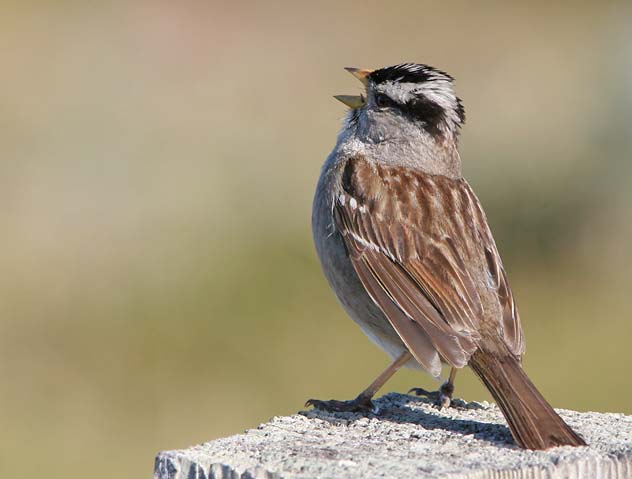 Most
North American sparrows are songsters. In the spring in northern
latitudes, the air is often filled with their song. Some of the songs
are sweet and melodic, including those of White-crowned Sparrow (right). This singing male is of the nuttalli
subspecies, restricted to a very narrow strip of dunes habitat along
the coast of California. There is another subspecies that nests in the
high mountains of California, and two more that migrate into the State
during winter. The nominate race only occurs well to be east. Sorting
out these subspecies has become an interesting proposition for birders;
see my page on this topic. Songs are
very helpful, and there has been a lot of acoustic research into the
songs of populations of White-crowned Sparrow. It has been proved that
songs are learned by youngsters by listening to their neighbors sing,
and the complexities of the songs show well in sonograms. Most
North American sparrows are songsters. In the spring in northern
latitudes, the air is often filled with their song. Some of the songs
are sweet and melodic, including those of White-crowned Sparrow (right). This singing male is of the nuttalli
subspecies, restricted to a very narrow strip of dunes habitat along
the coast of California. There is another subspecies that nests in the
high mountains of California, and two more that migrate into the State
during winter. The nominate race only occurs well to be east. Sorting
out these subspecies has become an interesting proposition for birders;
see my page on this topic. Songs are
very helpful, and there has been a lot of acoustic research into the
songs of populations of White-crowned Sparrow. It has been proved that
songs are learned by youngsters by listening to their neighbors sing,
and the complexities of the songs show well in sonograms. |
 Not all sparrow songs are impressive to human ears. Grasshopper Sparrow (left) puts enormous energy into delivering its song: a barely audible, thin katydid-like buzz. Not all sparrow songs are impressive to human ears. Grasshopper Sparrow (left) puts enormous energy into delivering its song: a barely audible, thin katydid-like buzz.
Song Sparrow (below left) sings throughout the day, but its formalistic set of trills is becomes monotonous. Spotted Towhee,
a large sparrow (below right), also seems to put its entire body into
the song: a stereotyped trill in many locations, but with distinct
local dialects.
Song Sparrow, like White-crowned, has
enormous size and plumage variation across North America. A slice of
that variation is discussed within a California Song Sparrows page. |
|
 Western North America has an amazing set of habitat-specific sparrows. Here are a couple of examples. Western North America has an amazing set of habitat-specific sparrows. Here are a couple of examples.
Black-chinned Sparrow
(left) prefers rocky habitat with sparse shrubs. This is found in some
desert canyons in southern California, but in northern California it
appears in recently burned areas and breeds only for a few years, until
the habitat grows up to thick. Males give a distinctive trilled song
that sounds like a dime spinning on a formica table top.
Bell's Sparrow lives in sage communities. The coast subspecies belli (below left) is resident in pockets of maritime chaparral and thicker sage chaparral in coastal mountains. The cannescens subspecies (below right) requires Atriplex sage communities. These populations were split as Bell's Sparrow recently, separated from Sagebrush Sparrow Artemisiospiza nevadensis. They were all once lumped as "Sage Sparrow." |
|
 |
Other North American sparrows have broad ranges across the continent, and much regional variation. Dark-eyed Junco
(left) was once split into four species [Slate-colored, White-winged,
Gray-headed, Oregon]. These are now lumped because of extensive
hybridization where ranges meet, but these taxa are still recognizable
in most cases. This one (left) is a singing "Oregon" type junco.
Fox Sparrow
(right) has much regional variation and many subspecies. There is talk
of splitting it into four species [Red, Sooty, Slate-colored,
Thick-billed]. Some of these taxa are recognizable by call note,. The
one shown here (right) is a "Thick-billed" type of Fox Sparrow. I have a separate page on variation in Fox Sparrows in Monterey County. Since that page was written, we have discovered a population of wintering 'Thick-billed' Fox Sparrow in Monterey County (below).
|
|
|
|
|
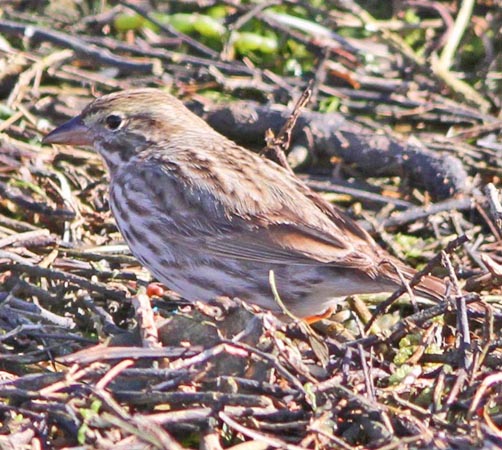 While
sparrows such as Song Sparrow, White-crowned Sparrow, and Dark-eyed
Junco may be ubiquitous and easily viewed across most of North America,
there are a selection of shy and elusive marshland sparrows that take
much effort to find. LeConte's Sparrow (above left) and Nelson's Sparrow
(above right) both breed in freshwater marshes in the northern center
of the continent but they winter primarily in salt marshes along the
east or southern coasts. Both are rare vagrants in California coastal
marshes where these photos were taken. While
sparrows such as Song Sparrow, White-crowned Sparrow, and Dark-eyed
Junco may be ubiquitous and easily viewed across most of North America,
there are a selection of shy and elusive marshland sparrows that take
much effort to find. LeConte's Sparrow (above left) and Nelson's Sparrow
(above right) both breed in freshwater marshes in the northern center
of the continent but they winter primarily in salt marshes along the
east or southern coasts. Both are rare vagrants in California coastal
marshes where these photos were taken.
Savannah Sparrow Passerculus sandwichensis is another common and widespread New World sparrow, but the race rostratus
breeds only in the the delta of the Colorado River, Baja California. In
fall and winter, it disperses and occurs in small numbers in coastal
southern California and at the Salton Sea, where it sneaks around in
salt marshes. There have been suggestions for years that it should be
elevated to a separate species, Large-billed Sparrow P. rostratus
(right) but the split has not yet occurred. It was just recently found
farther north in central California coastal salt marshes (this photo).
Watch for the bird and the 'split' in the future. |
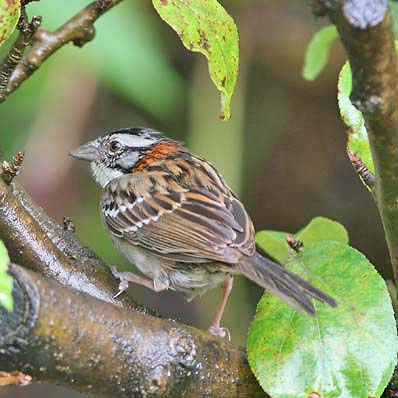 There
are New World sparrows in the Neotropics, and only now are the
parameters becoming clear. There are a few sparrows, including the
ubiquitous Rufous-collared Sparrow (right) that
ranges from Central America down through the Andean spine of South
America. Mexico has an extensive set of sparrow. There
are New World sparrows in the Neotropics, and only now are the
parameters becoming clear. There are a few sparrows, including the
ubiquitous Rufous-collared Sparrow (right) that
ranges from Central America down through the Andean spine of South
America. Mexico has an extensive set of sparrow.
Some specialized emberizids in montane Costa Rica and western Panama include the well-named Yellow-thighed Finch (below left), shown here eating berries.
Initial genetic data (Burns et al. 2002, Yuri & Mindell 2002) indicated the genus Chlorospingus
was not a member of the Thraupidae, and more recent research suggests
that it best handled as a member of the New World sparrows (Klicka et
al. 2007). Bush-tanagers travel in small active flocks in Neotropical
mountains. There are a couple of species in South America, and several
in Central America, including Sooty-capped Bush-Tanager (below right). |
|
|
Another set of Neotropical species within this family are brushfinches: 10 species in genus Arremon and 20 species in Atlapetes.
These genera are not each other's closest relatives so in a checklist
the two sets of brushfinches are separated by sequences of other
sparrows. Yellow-breasted Brushfinch (above) is a member of the Atlapetes brushfinches, secretive and mostly ground-dwelling sparrows. Its Andean range extends from Colombia through Peru.
New World sparrows are a significant component of bird life in the Nearctic. Each year wintering Golden-crowned Sparrows Zonotrichia atricapilla
arrive in September at my backyard feeder, and linger to late April.
Each year rarer sparrows appear as well, usually briefly. The rarest
sparrow so far was this Green-tailed Towhee (below)
that spent the winter here in 2002–2003. Rita nicknamed it "Pipilo" and
we checked on it daily. During its last week it was in full song before
departing. |
|
| |
Photos: The Lark Sparrow Psophia crepitans at Junglaven, Venezuela, in March 2007. The 'Nuttall's' White-crowned Sparrow Zonotrichia leucophrys nuttalli was on the Pacific Grove seashore, California, on 7 Apr 2010. The nominate race Grasshopper Sparrow Ammodramus savannarum was singing at Antietam National Battlefield, Maryland, on 16 June 2009. The Song Sparrow Melospiza melodia was at Moss Landing 6 Apr 2010. The singing Spotted Towhee Pipilo maculatus was at Big Sur R. mouth, California, 29 May 2010. The Black-chinned Sparrow Spizella atrogularis was at Chews Ridge on 3 June 1984. The 'belli' Bell's Sparrow Artemisiospiza belli belli was at Ft. Ord, Monterey Co., California, on 21 Apr 2009. The 'cannescens' Bell's Sparrow A. b. cannescens was in Carrizo Plains National Monument, California, on 28 Mar 2010. My local race of Oregon Dark-eyed Junco Junco hyemalis pinosus was at Arroyo Seco, California, on 24 July 2006. The 'Thick-billed' Fox Sparrow Passerella iliaca megarhyncha
was at Kings Canyon Nat'l Park, California, on 12 May 2002, while the
wintering individual was near Cone Peak, Monterey County, California,
on 17 Jan 2015. The vagrant LeConte's Sparrow Ammodramus leconteii was at Abbotts Lagoon, Marin Co., California, on 9 Jan 2015; the vagrant Nelson's Sparrow Ammodramus nelsoni was on Elkhorn Slough, Monterey Co., California, on 4 Jan 2015. The 'Large-billed' Savannah Sparrow Passerculus [sandwichensis] rostratus was at Moss Landing, Monterey Co., on 12 Dec 2015. The Rufous-collared Sparrow Zonotrichia capensis was at Savegre, Costa Rica, on 23 Dec 2007; the Yellow-thighed Finch Pselliophorus tibialis and Sooty-capped Bush-Tanager Chlorospingus pileatus were photographed there the next day. The Yellow-breasted Brushfinch Atlapetes latinuchus was at Huembo Reserve, Peru, on 24 Nov 2014. The Green-tailed Towhee Pipilo chlorurus was digiscoped in my Pacific Grove backyard, California, on 3 Feb 2003.
All photos © Don Roberson; all rights reserved.
Bibliographic note: There is no "family book" that covers all of the Passerellidae but the Handbook of the Birds of the World
account (Rising 2011) did so, in a very expansive Emberizidae (326
species!) that included many groups (including many finches and
seedeaters) now more properly placed among tanagers [Thraupidae]. This account is full of wonderful photos. Further, there are two books that cover a fair portion of the family:
Byers, Clive, Jon Curson, and Urban Olsson. 1995. Sparrows and Buntings. 
This
book is structured like a standard "family book" of the period, with
color plates in front and text in back. The odd subtitle is "A Guide to
the Sparrows and Buntings of North America and the World." I say "odd"
since "buntings of North America" are not covered (e.g., Indigo Bunting
et al.). Rather, the subtitle should have been "Guide to Nearctic
Sparrows and Palearctic Buntings." The buntings of the Old World are
all included, but the only Neotropical sparrows are of Nearctic genera.
Also included are longspurs and Snow Bunting, now assigned to a
separate family. The maps are in the text, not with the plates. The
plates are okay, and quite nice for a quick look-through of sparrows
and buntings, but do not really look like the birds I know, such as
California Towhee. Worse, the attempt to show geographic variation in
Fox Sparrow and Song Sparrow does not match the subspecies attempted,
except in the most basic way. The text is also okay, but not thorough,
and did not really cover the difficult i.d. points in North America. As
the authors are all European, I assume that the text on Old World birds
is much better.
Rising, James D., and David D. Beadle. 1996. 
A Guide to the Identification and Natural History of the Sparrows of the United States and Canada.
This
thinnish volume from Academic Press was quite good for its decade. It
covers only the sparrows of the U.S. and Canada (plus longspurs and
Snow/McKay's buntings, now it a different family), with color plates in
the back, and text (with maps) in the front. I like some of Beadle's
artwork, but again the California/Canyon Towhees are not that good. The
attempt to capture variation in plumage, size & shape in Song and
Fox Sparrows is a bit better than Byers et al., but still not accurate.
I do like the text, though, especially for its natural history and
taxonomic discussions. Rising is a respected sparrow researcher.
However, it is not an in-depth guide to sparrow identification,
notwithstanding the title.
Literature cited:
Burns,
K.J., S.J. Hackett, and N.K. Klein. 2002. Phylogenetic relationships
and morphological diversity in Darwin's finches and their relatives.
Evolution 56: 1240-1252.
Burns, K.J., and K. Naoki. 2004. Molecular phylogenetics and biogeography of Neotropical tanagers in the genus Tangara. Molec. Phylog. Evol. 32: 838-854.
Byers,
C., J. Curson, and U. Olsson. 1995. Sparrows and Buntings: A Guide to
the Sparrows and Buntings of North America and the World. Houghton
Mifflin, Boston.
Klicka, J., K. Burns, and G.M. Spellman. 2007. Defining a monophyletic
Cardinalini: A molecular perspective. Molec. Phylog. Evol. 45: 1014
1032.
Klicka, J., K. P. Johnson, and S. M. Lanyon.
2000. New World nine-primaried oscine relationships: constructing a
mitochondrial DNA framework. Auk 117: 321-336.
Rising, J.D. 2010. Family Emberizidae (Buntings and New World Sparrows), pp. 428 –683 in
Handbook of the Birds of the World (del Hoyo, J., A. Elliott, J.
Sargatal & D.A. Christie, eds). Vol. 16. Lynx Edicions, Barcelona,
Spain.
Rising, James D., and David D. Beadle.
1996. A Guide to the Identification and Natural History of the Sparrows
of the United States and Canada. Academic Press, New York.
Yuri,
T., and D.P. Mindell. 2002. Molecular phylogenetic analysis of
Fringillidae, "New World nine-primaried oscines" (Aves: Passeriformes).
Molec. Phylog. Evol. 23: 229-243.
|
|
|


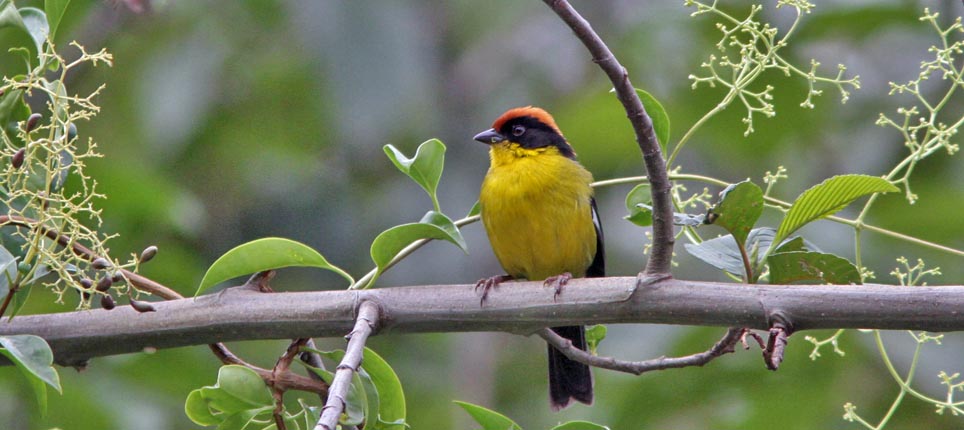
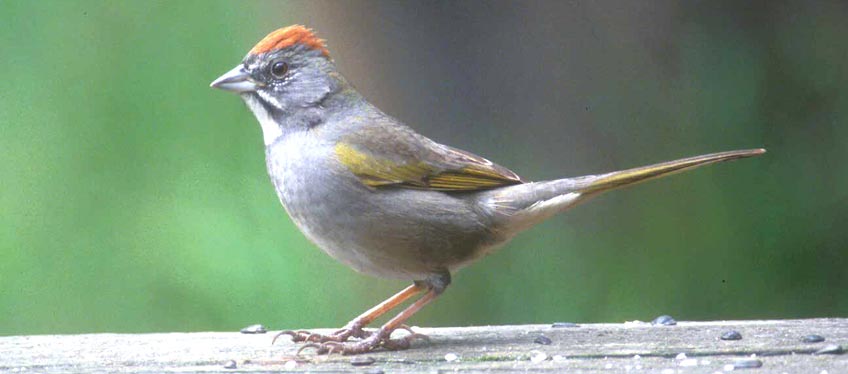
 Not all sparrow songs are impressive to human ears. Grasshopper Sparrow (left) puts enormous energy into delivering its song: a barely audible, thin katydid-like buzz.
Not all sparrow songs are impressive to human ears. Grasshopper Sparrow (left) puts enormous energy into delivering its song: a barely audible, thin katydid-like buzz. 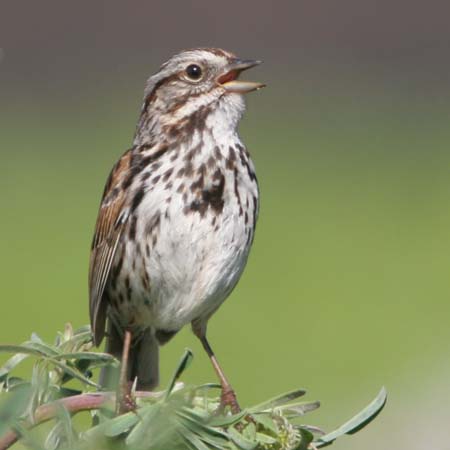
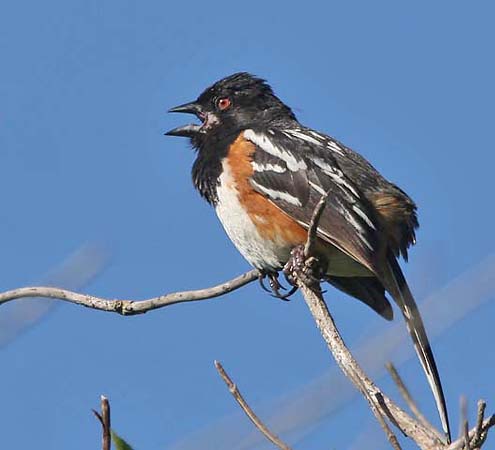
 Western North America has an amazing set of habitat-specific sparrows. Here are a couple of examples.
Western North America has an amazing set of habitat-specific sparrows. Here are a couple of examples. 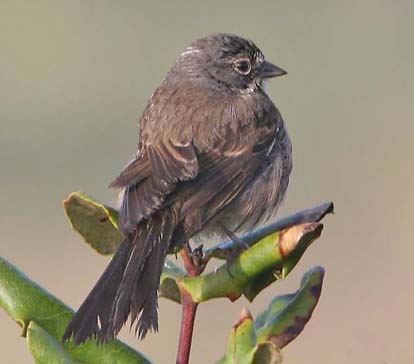
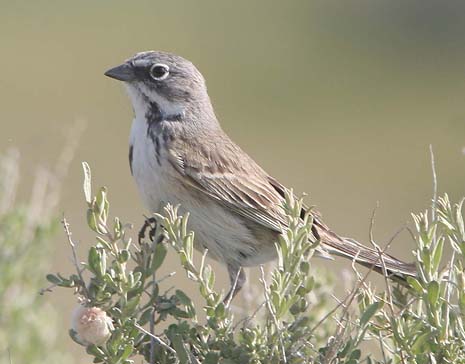

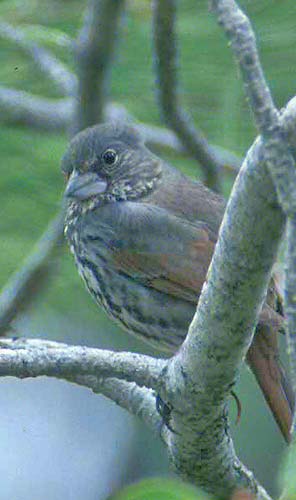
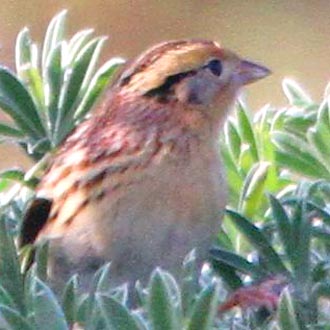
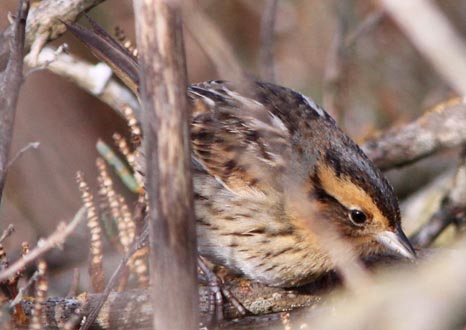
 While
sparrows such as Song Sparrow, White-crowned Sparrow, and Dark-eyed
Junco may be ubiquitous and easily viewed across most of North America,
there are a selection of shy and elusive marshland sparrows that take
much effort to find. LeConte's Sparrow (above left) and Nelson's Sparrow
(above right) both breed in freshwater marshes in the northern center
of the continent but they winter primarily in salt marshes along the
east or southern coasts. Both are rare vagrants in California coastal
marshes where these photos were taken.
While
sparrows such as Song Sparrow, White-crowned Sparrow, and Dark-eyed
Junco may be ubiquitous and easily viewed across most of North America,
there are a selection of shy and elusive marshland sparrows that take
much effort to find. LeConte's Sparrow (above left) and Nelson's Sparrow
(above right) both breed in freshwater marshes in the northern center
of the continent but they winter primarily in salt marshes along the
east or southern coasts. Both are rare vagrants in California coastal
marshes where these photos were taken.  There
are New World sparrows in the Neotropics, and only now are the
parameters becoming clear. There are a few sparrows, including the
ubiquitous Rufous-collared Sparrow (right) that
ranges from Central America down through the Andean spine of South
America. Mexico has an extensive set of sparrow.
There
are New World sparrows in the Neotropics, and only now are the
parameters becoming clear. There are a few sparrows, including the
ubiquitous Rufous-collared Sparrow (right) that
ranges from Central America down through the Andean spine of South
America. Mexico has an extensive set of sparrow. 

